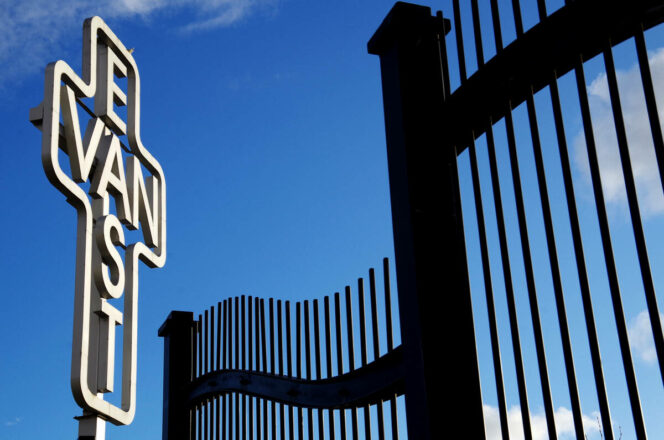
East Vancouver Cross by artist Ken Lum; Destination Vancouver/Megan Richter
As a multicultural city with rich arts and culture, Vancouver offers a diverse array of ways to appreciate local art. In addition to a range of galleries, the city has a thriving street and public art scene, allowing you to explore unique neighbourhoods while also appreciating art.
Below is a guide to what you need to know about street and public art in Vancouver:
Indigenous and Inuit Art and Culture
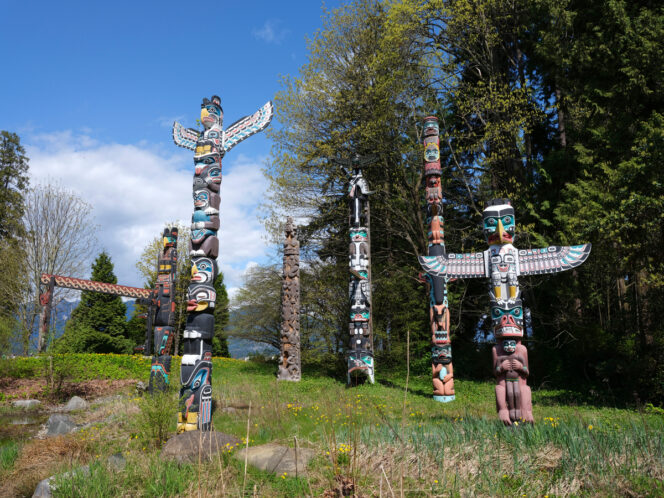
Nine totem poles stand tall in Stanley Park (Destination Vancouver/Kazutoish Yoshimura).
Vancouver, which is located on the traditional, ancestral, and unceded territories of the Sḵwx̱wú7mesh (Squamish), Səl̓ílwətaʔ/Selilwitulh (Tsleil-Waututh) and xʷməθkʷəy̓əm (Musqueam) Nations, is home to numerous impressive works of Indigenous art. This art has significant cultural, historical, and ancestral significance.
The nine totem poles at Brockton Point are particularly well known, representing a collection of totem poles dating back to the late 1880s and originating from Alert Bay, Haida Gwaii, and Rivers Inlet. The most recent one by Robert Yelton (Squamish Nation) was added in 2009. Other totem poles can be found at UBC’s Museum of Anthropology (Note: MOA is closed until June 2024) surrounding a Haida house; and at Capilano Suspension Bridge Park.
Stanley Park is home to other Indigenous works of art. Coast Salish artist Susan Point created People Amongst the People, which consists of three Coast Salish red cedar gateways that invite a visitor into traditional Coast Salish territory. At Brockton Point, you can also find Shore to Shore by Luke Marston (Chemainus First Nation), a bronze sculpture mounted on engraved Portuguese stone that commemorates the link between Coast Salish peoples and the Portuguese. And at the Miniature Railway Plaza in the Park, you can admire Raven: Spirit of Transformation, a Douglas fir stump that was carved into a raven by Richard Krentz (Sechelt Nation) after a damaging windstorm in 2006.
Another iconic piece of art in Vancouver is the Inuit Inukshuk by Alvin Kanak, located at the foot of Bidwell Street. The stacked granite boulders symbolize welcome, with the Inukshuk originally made for the Northwest Territories pavilion at Expo 86.
You can also learn more about contemporary Indigenous art by walking the North Vancouver Spirit Trail, which follows the gorgeous waterfront and contains numerous works of Indigenous art, including the Fisher Family Totem and Spirit Trail Benches. And Vancouver Mural Festival (VMF)’s initiative Blanketing the City, is an incredibly exciting collaboration with Musqueam weaver and designer Debra Sparrow who has invited other master weavers to help design stunning murals that embody Indigenous reclaiming of the land and proud cultural resurgence. Public Art Vancouver’s Platforms: Nine Places for Seeing is also a great project showcasing Indigenous art (see below).
Public Art Vancouver
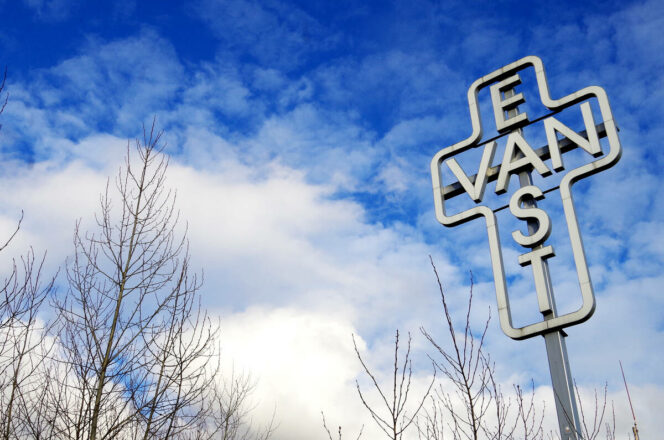
East Vancouver Cross by artist Ken Lum; Destination Vancouver/Megan Richter
The City of Vancouver’s Public Art Vancouver program works to incorporate public art into their municipal planning by commissioning artists, thereby building lively spaces for social interaction and engagement. Current projects include Platforms: Nine Places for Seeing, a commissioning of 21 local Indigenous artists for temporary art installations that will appear between 2023 and 2025. Currently available for viewing are works such as Kitty Guerin’s banners in the central atrium of the Vancouver Public Library Central Branch (until May 2024) and Lauren Crazybull’s Present Presence on the glasswall of the Marine Drive Canada Line Station (until June 2024). Another project is Home + Away, public art/seating at Hastings Parks’ Empire Fields, slated for completion in spring 2024.
Public Art Vancouver also collaborates with other art initiatives such as Vancouver Art Gallery Offsite, the Canada Line Public Art Program, and The WALL, which champions large format public art.
You can also search a public art registry to find the locations of beloved works of public art, such as Ken Lum’s Monument for East Vancouver and McFanwy MacLeod’s The Birds in Olympic Village.
Vancouver Mural Festival
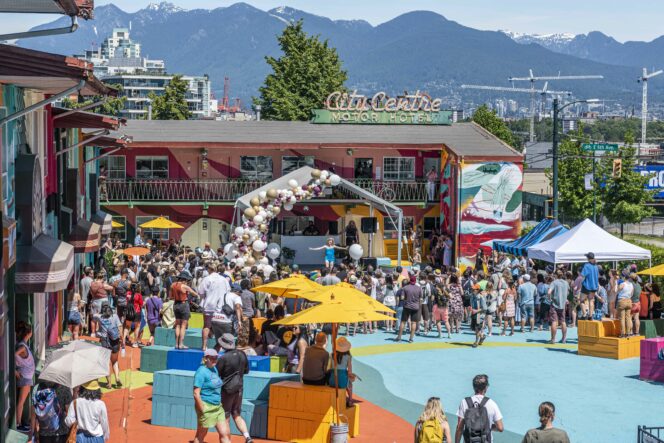
Vancouver Mural Festival at City Centre Artist Lodge; Photo: Gabriel Martins
Launched in 2016, Vancouver Mural Festival (VMF) is a non-profit organization committed to furthering the artistic life of Vancouver, particularly focused on creating space for Indigenous creative expression as well as artists of diverse backgrounds. They perceive murals to be a key means of building community, furthering neighbourhood pride, as well as engaging in reconciliation with First Nations peoples. To date, they have helped bring into being over 400 murals.
VMF organizes two key annual festivals: the Vancouver Mural Festival, which usually takes place in August with a plethora of new murals across the city as well as fun events (e.g., Mount Pleasant Street Party); and the VMF Winter Arts, a multi-day festival in February that combines events, tours, installations, sculptures, live performances, and Augmented Reality (AR).
Outside of their two large festival, fans of mural art can use the VMF app to find the locations of all the works, in addition to learning about the artists and their creations. A great strategy is to select particular neighbourhoods you want to get to know, and then use the map in the app as you walk or cycle around the area. Alternatively, the app also groups the murals by collections, such as Indigenous murals, family fun murals, and murals attached to specific festival years, as well as by artists, giving you the tools to customize your mural tour to your interests.
Vancouver Biennale
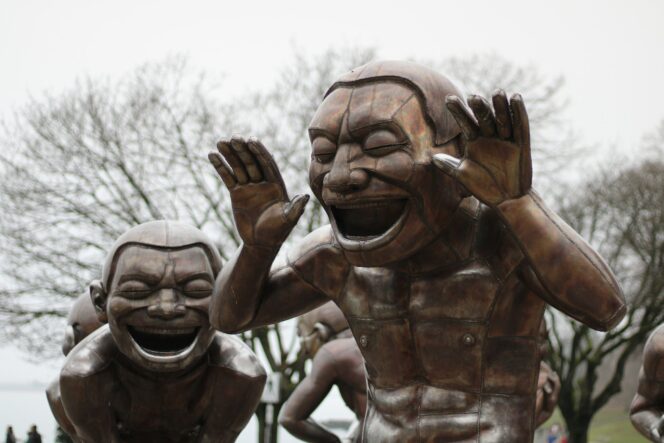
A-maze-ing Laughter; Photo: Debbie Konrad/Unplash
Vancouver Biennale officially became a non-profit organization in 2024 but it’s exciting work began in 1998 with a collaboration with the Vancouver Parks Board. Since then, the organization has played a significant role in furthering international public art in key locations throughout the city. To date, 91 public installations, representing 78 artists from 25 countries, have been featured through the Vancouver Biennale’s work, which encompasses an international artist residency program. Current art includes very popular pieces such as A-maze-ing Laughter by Yue Minjun from China, consisting of large bronze statues hysterically laughing at their location at English Bay (Davie Street and Denman Street); and 217.5 Arc x 13, steel ribs by Bernar Venet at Sunset Beach (Beach Avenue and Jervis Street).
You can locate all the public art on a map. Or, you can take part in BIKEnnale or WALKennale, self-guided cycling and walking tours (e.g., Destination Downtown Walk) that take you through scenic areas while admiring public art. Note: some of the artwork on the maps have been removed since the creation of the maps.
Self-Guided Tours
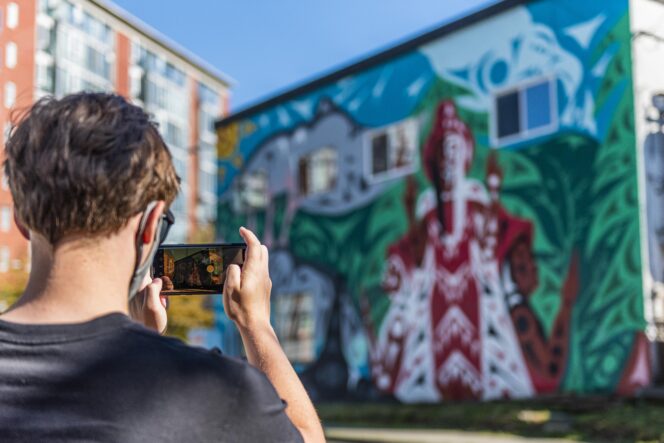
Vancouver Mural Festival Artist Siobhan-Joseph; Photo Credit: Gabriel Martins
Whether it’s on foot, bicycle, e-scooter, or transit, Vancouver’s public art is incredibly accessible and open for everyone to enjoy and admire. Many of the works are also educational, making a tour of some of them a wonderful family-friendly activity. The VMF offers tours during the Vancouver Mural Festival and the Winter Fair, while there are maps from the VMF (app), Vancouver Biennale, and Public Art Vancouver for tailoring your own self-guided public art tour. Along the routes, you’ll be sure to see beautiful Vancouver scenery and gain an appreciation for the city’s lively and constantly evolving neighbourhoods.

















4 Responses to Where and How to Appreciate Vibrant Public Art in Vancouver